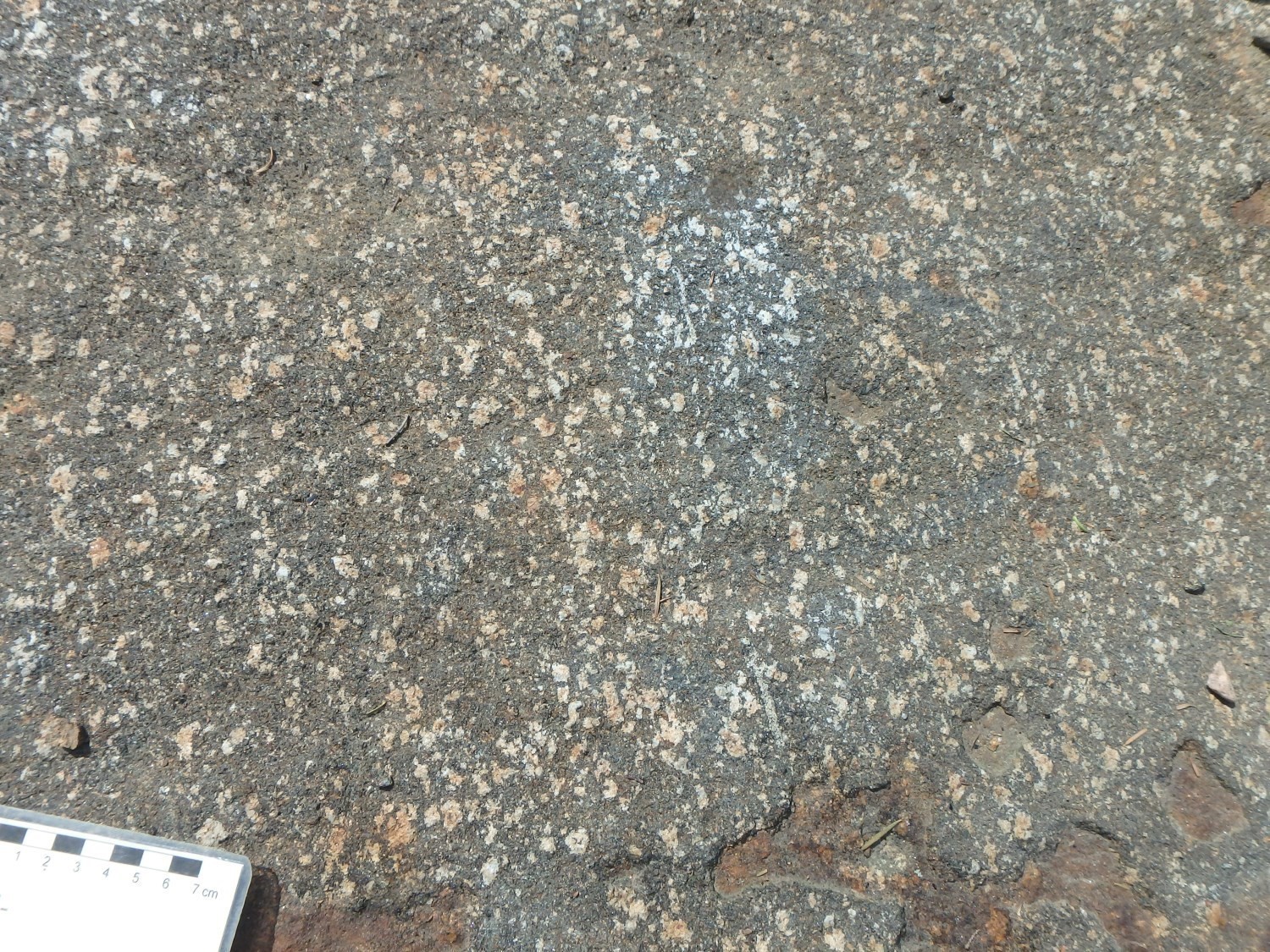
Last modified:
Translation of original French
| Author: | Moukhsil et al., 2015 |
| Age: | Mesoproterozoic |
| Reference section: | Reference outcrops 14-AM-007 (mPbog1) and 14-TC-5022 (mPbog2) |
| Type area: | NTS sheet 32B02 |
| Geological province: | Grenville |
| Geological subdivision: | Allochton |
| Lithology: | Syenite, granite, websterite, gabbronorite |
| Type: | Lithodemic |
| Rank: | Lithodeme |
| Status: | Formal |
| Use: | Active |
None
Background
The Bourguet Syenite was identified by Moukhsil et al. (2015) during mapping of the Parent region, Haut-Saint-Maurice.
Description
Bourguet Syenite 1 (mPbog1): Alkali Feldspar-Megacristic Biotite-Clinopyroxene-Apatite Syenite, Alkaline Syenite Dykes, Granite, Websterite
 This unit is the main facies of the Bourguet Syenite. It occupies the centre of the intrusion and consists of megacristic syenite with bluish grey K-feldspar phenocrystals (up to 4 cm long). It also contains magnetite, biotite, clinopyroxene, apatite and traces of ilmenite and titanite. K-feldspar phenocrystals are perthitic, contain apatite and biotite inclusions, and locally have Carlsbad twinning (orthose) without significant deformation. Phenocrystals display a slight preferential orientation, thus testifying to a magmatic texture of syenite. On the other hand, the host of the intrusion is highly deformed, developing mylonitization (shearing); straight and banded gneiss are observed.
This unit is the main facies of the Bourguet Syenite. It occupies the centre of the intrusion and consists of megacristic syenite with bluish grey K-feldspar phenocrystals (up to 4 cm long). It also contains magnetite, biotite, clinopyroxene, apatite and traces of ilmenite and titanite. K-feldspar phenocrystals are perthitic, contain apatite and biotite inclusions, and locally have Carlsbad twinning (orthose) without significant deformation. Phenocrystals display a slight preferential orientation, thus testifying to a magmatic texture of syenite. On the other hand, the host of the intrusion is highly deformed, developing mylonitization (shearing); straight and banded gneiss are observed.
Salmon-pink alkaline syenite dykes and minor amounts of websterite and granite are associated with this unit. Syenite dykes are fine-grained and cut the main facies. They are foliated and perthitic K-feldspar megaporphyric (40-65% of the rock, 1-3 cm long). Both types of dykes are composed of interstitial biotite, with small amounts of orthopyroxene, magnetite, ilmenite and apatite as accessory minerals. Websterite is green in fresh exposure, medium grained and contains clinopyroxene, orthopyroxene, biotite, olivine and green hornblende. Accessory minerals are apatite and ilmenite. Granite associated with syenite is pinkish and coarse grained. It is composed of quartz, plagioclase, K-feldspar, usually perthitic and opaque minerals.
Bourguet Syenite 2 (mPbog2): Fe-Ti-P Oxide Gabbronorite, Feldspar Xenocrystal Porphyritic
 This unit is located on the northern periphery of the intrusion. It consists of Fe-Ti oxides-apatite gabbronorite (type OAGN = Oxide Apatite Gabbronorite, acronym according to Dymeck and Owens, 2001), characterized by a porphyritic texture with K-feldspar xenocrystals. These rectangular-shaped xenocrystals (2 mm to 1 cm long) are of the same composition as phenocrystals of the main syenite unit (mPbog1). Gabbronorite is medium to coarse grained, highly magnetic, consisting of poikiloblastic biotite crystals (~1 cm long), clinopyroxene, orthopyroxene, plagioclase, magnetite, hornblende, apatite and trace sulphides (pyrrhotite, chalcopyrite). There is also the presence of normative ilmenite.
This unit is located on the northern periphery of the intrusion. It consists of Fe-Ti oxides-apatite gabbronorite (type OAGN = Oxide Apatite Gabbronorite, acronym according to Dymeck and Owens, 2001), characterized by a porphyritic texture with K-feldspar xenocrystals. These rectangular-shaped xenocrystals (2 mm to 1 cm long) are of the same composition as phenocrystals of the main syenite unit (mPbog1). Gabbronorite is medium to coarse grained, highly magnetic, consisting of poikiloblastic biotite crystals (~1 cm long), clinopyroxene, orthopyroxene, plagioclase, magnetite, hornblende, apatite and trace sulphides (pyrrhotite, chalcopyrite). There is also the presence of normative ilmenite.Thickness and distribution
This intrusion is roughly elliptical, approximately 7.5 km long and 4 km wide, with a NW-SE orientation. Two small intrusions are also visible northwest of the main intrusion.
Dating
Unit mPbog1 was dated during mapping of the Parent region and gave a crystallization age of 1038 +15/-13 Ma.
| Isotopic System | Mineral | Crystallization Age (Ma) | (+) | (-) | Reference(s) |
| U-Pb | Zircon | 1038 | 15 | 13 | Augland et al., 2016 |
Stratigraphic Relationship(s)
The Bourguet Syenite intrudes into the Dugré Plutonic Suite and Wabash Complex.
Paleontology
Does not apply.
References
| Author(s) | Title | Year of Publication | Hyperlink (EXAMINE or Other) |
|---|---|---|---|
| MOUKHSIL, F. – SOLGADI, F. – BELKACIM, S. – AUGLAND, L.E. – DAVID, J. | Géologie de la région de Parent, Haut-Saint-Maurice (Partie ouest du Grenville). Ministère de l’Énergie et des Ressources naturelles, Québec, 62 pages, 1 map. | 2015 | RG 2015-04 |
| DYMEK, P.F. – OWENS, B.E. | Petrogenesis of apatite-rich rocks (nelsonite and oxyde-apatite-gabbronorite) associated with massif anorthosites. Economic Geology, volume 96, pages 797-815. | 2001 | Source |
|
AUGLAND, L.E. – MOUKHSIL, A. – SOLGADI, F. |
Mantle influence of syn- to late-Grenvillian alkaline magmatism in the Grenville Province: causes and implications. Canadian Journal of Earth Science, volume 54, pages 263-277. | 2016 | Source |

